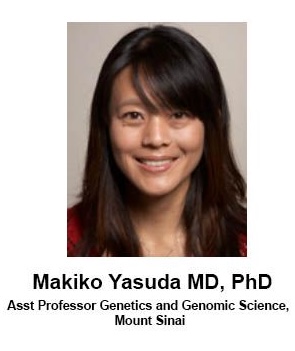Congratulations to Utah CCEH P&F recipient Dr. Makiko Yasuda on her new NIDDK awarded R01 entitled “Mechanisms of Intercellular Heme Homeostatis in Liver”. Watch for this Rising Star in Heme and Iron research!
PI: Makiko Yasuda, MD PhD Mount Sinai
Title: Mechanisms of Intercellular Heme Homeostasis in Liver
Funding Agency: NIDDK
Summary: The long-term goal of this grant is to obtain a comprehensive understanding of the intercellular mechanisms involved in the maintenance of organismal heme homeostasis. In mammals, heme, an iron-containing cofactor and signaling molecule, is synthesized in all nucleated cells and is essential for a diverse array of fundamental biological processes. As a hydrophobic and cytotoxic molecule, heme must be transported in a highly controlled manner through membranes via specific cellular pathways. The current paradigm posits that mammalian cellular heme homeostasis is maintained solely by the balance between heme biosynthesis, driven by 5-aminolevulinic acid synthase (ALAS), and heme degradation. While the discovery of eukaryotic heme transporters has given rise to the emerging notion that inter- and intra-cellular heme trafficking pathways also contribute to the maintenance of heme homeostasis, the pathways and mechanisms that mediate heme homeostasis outside of the context of heme biosynthesis and heme degradation remain poorly understood. Our recent unpublished studies using a newly generated hepatocyte-specific ALAS knockout mouse model (Alas1/2KO mice) strongly suggest that hepatocytes acquire “on demand” heme from reticuloendothelial macrophages through a currently unexplored intercellular heme homeostatic pathway. In this proposal, we will test our paradigm-shifting hypothesis that hepatocytes maintain cellular heme homeostasis by acquiring a substantial portion of their heme from macrophages using the Alas1/2KO mice. To this end, Specific Aim 1 will identify the cell types that are directly involved in heme transfer from macrophages to hepatocytes by establishing an in vitro primary liver cell co-culture system. Specific Aim 2 will employ in vivo approaches to identify key molecules involved in the hepatocyte heme acquisition pathway and to investigate the mechanisms by which the acquisition system is activated. Specific Aim 3 will identify additional candidate genes and pathways that drive hepatocyte heme acquisition using single cell RNA sequencing. These studies will advance our understanding of how liver maintains heme homeostasis in health and disease and aid in improving our understanding of the pathogenesis of the life-threatening acute neurovisceral attacks that occur in the acute hepatic porphyrias.





